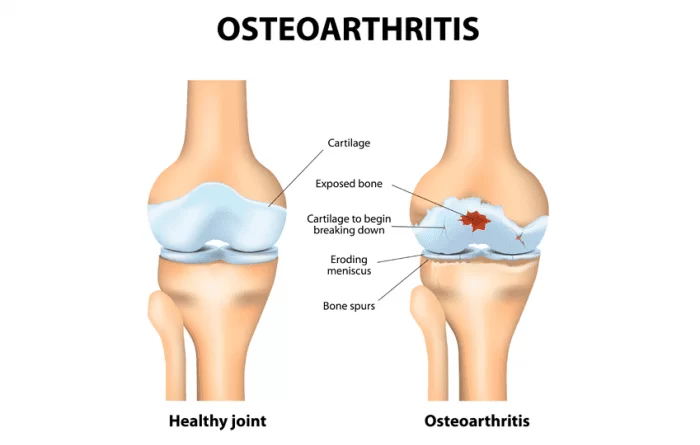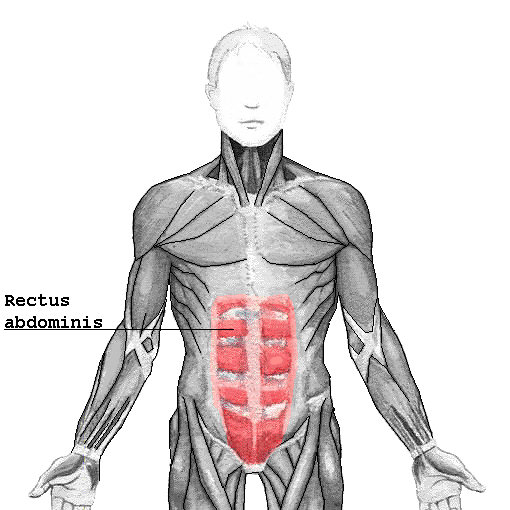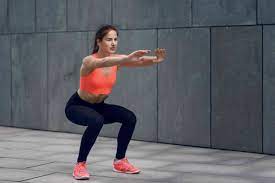Exercise for Frozen shoulder
Table of Contents
Exercise for frozen shoulder
Exercise for frozen shoulder is the most preferred treatment of choice worldwide to restore the function of the shoulder joint naturally, It helps to improve range of motion (ROM), strengthen weak muscles, and also improve flexibility.
Frozen shoulder also called adhesive capsulitis is a common disorder that causes pain, stiffness, and loss of normal movement in the shoulder. The resulting disability can be serious, and the condition tends to get worse with time if it is not treated. It affects mainly people ages 40 to 60 years women more rather than men.
Sometimes frozen joints happen because the shoulder has been immobilized for a long time by injury, surgery, or illness. In many cases the cause is obscure. Fortunately, the shoulder can generally be unfrozen, even so, full recovery takes time and lots of self-help.
The shoulder has a wide and more miscellaneous range of motion than any other part of the body. It is a pivot joint mainly on a ball-and-socket arrangement called the glenohumeral joint. it is connected to the top of the humerus (upper arm bone) to a scoop-out part of the scapula (shoulder blade) called the glenoid cavity.
Which goals are achieved with exercise in Frozen Shoulder?
Exercise helps to achieve the following goals in Frozen shoulder:
- To reduce Shoulder pain
- To prevent joint stiffness
- To increase the extensibility of thickened and contracted capsule of the shoulder joint
- To restore or regain range of motion
- To improve the strength of the Shoulder muscle
- Improvement in shoulder discomfort
- Improvement of shoulder movement in all plane
- Improvement of power and endurance of rotator cuff muscle and scapular stabilizer
- To improve the activity of daily living
Health Benefits of exercise for Frozen shoulder
- Improve movement efficiency
- Improve independence
- Decrease pain
- Improve and maintain joint integrity
- Maintain muscular properties
- Increase range of motion
- increase venous and lymphatic drainage
- induce relaxation
- maintain muscular properties
- increase the range of motion of the shoulder
- increase venous and lymphatic drainage
- induce relaxation of Shoulder muscles
Exercise for Frozen Shoulder
Relax passive movement for frozen shoulder
Shoulder flexion
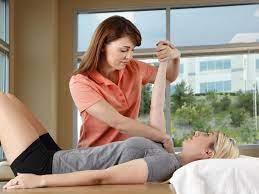
- patient position: supine lying
- position of therapist: stand beside the patient
- procedure: therapist’s left hand restricts the wrist and carpometacarpal movement
therapist’s right hand should grasp the lower part of an arm of the patient .mild long axial traction is applied and maintain the traction through the movement
In the beginning, stage traction is applied by the right hand and above 90-degree traction maintain by the therapist’s left hand
perform the movement up to an available range
Shoulder extension
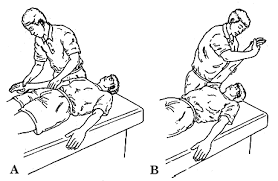
- patient position: side lying, supine
- position of therapist: stand back side of patient face shoulder joint
- procedure: forearm and elbow are placed over right side forearm of the therapist by flexion of the elbow of patient wrist movement restricts by therapist’s hand
- the left hand of the therapist stabilizes the shoulder joint of the patient and the therapist’s right hand performs extension movement
shoulder abduction

- patient position: supine lying, sitting
- position of therapist: stand beside the patient and face the patient face
- procedure: patient elbow flex 90 degrees .wrist grasp by the left hand of therapist .dorsal aspect of the elbow and lower part of the arm is grasped by therapist’s right hand .therapist’s both hand perform abduction movement of the shoulder
Shoulder medial and lateral rotation
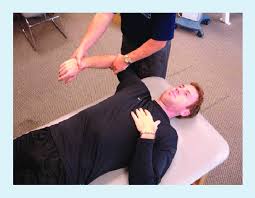
- patient position: supine lying
- position of therapist: stand behind the patient
- procedure: patient’s shoulder abducted 90 degrees and elbow flex 90 degrees.
- the therapist’s left hand grasped the lower end of the humerus of the patient and the right-hand grasped wrist and hand of the patient.
- long axial traction applies and medial, and lateral rotation of the shoulder is performed
Indication for relaxed passive movement for frozen shoulder
- the patient who can’t perform active movement
- the patient who can’t perform a full range of movement
- the patient is totally on bed rest
multi-angle isometrics: ask the patient to perform shoulder movement and the therapist resists the force of movement and the patient has to match the same force
Isometric Shoulder Exercises
Isometric Shoulder Flexion
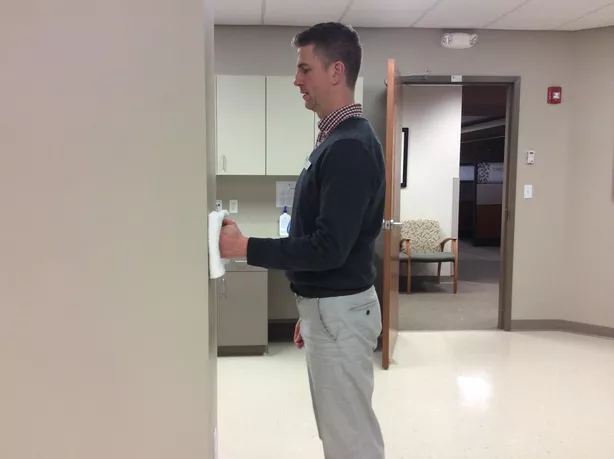
- Stand facing a wall.
- Bend the elbow on the affected side and make a fist.
- Place a folded towel between the fist and the wall, and gently press the hand into the wall.
- Hold for five seconds
- this exercise is used to activate shoulder muscle
- do 10 to 15 repitation
Isometric Shoulder Abduction

To perform isometric shoulder abduction exercises:
- Stand about six inches from a wall, but turn the body so it is perpendicular to the wall.
- The shoulder of the affected side should be close to the wall.
- Make a fist and press it into the wall, use a folded-up towel for a little extra comfort.
- Gently press into the wall as if you are trying to lift your arm out to the side, and hold it for five seconds.
- Slowly release pressure on the wall.
- Perform 10 to 15 repetitions
Isometric Shoulder External Rotation

- It is an exercise that can help strengthen rotator cuff muscles, specifically teres minor, infraspinatus.
- To perform the exercise:
- Continue to stand perpendicular to a wall about six inches from it.
- The shoulder of the affected side should be closest to the wall.
- Bend the elbow 90 degrees, make a fist, and press the back of the hand into the wall as a rotating arm outwards.
- Gently press the hand into the wall for about five seconds.
- Slowly release pressure on the wall.
- Do 10 to 15 repetitions
Isometric Shoulder Internal Rotation

- To perform isometric shoulder internal rotation:
- Position of the body: face a door frame or an outside corner of a wall.
- The shoulder of the affected side should be near the door opening or corner.
- Bend the elbow 90 degrees, make a fist, and gently press into the corner wall or door jamb as if you were trying to rotate your hand inward towards your belly button.
- Use a small folded towel for protection.
- hold for five seconds
- Perform 10 to 15 repetitions
Isometric Shoulder Extension
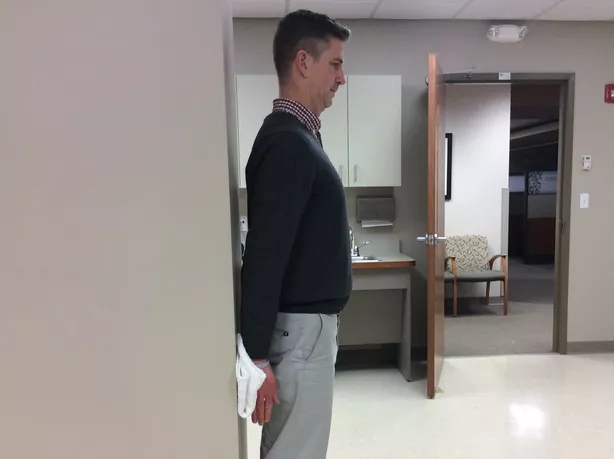
- To perform isometric shoulder extension:
- Stand about six inches away from a wall with your back facing it.
- Keep the elbow straight so the hand is down near your hip.
- Make a fist, and gently press it into the wall behind you.
- very little motion should occur at the shoulder.
- Hold the pressure against the wall for 5 seconds, and release slowly.
- Do 10 to 15 repetitions.
Stretching exercise for frozen shoulder
- Take a warm bath or shower for 10 to 15 minutes before starting exercise for frozen shoulder
Pendulum stretch

- This exercise is done first.
- Relax the shoulders.
- Stand or lean over slightly and allow to affected arm to hang down.
- The arm Swing in a small circle — about the foot diameter.
- Perform the 10 repetitions in each direction, once a day.
- When the improve in symptoms, increase the swing diameter, but not force it.
- If the patient is ready for more circles, then increase the stretch with hold lightweight for the swinging arm
Towel stretch
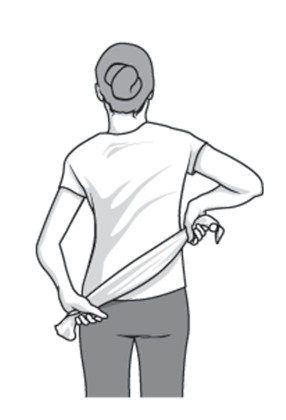
- Hold the three-foot-long towel in one end behind the back and hold the opposite end with the other hand.
- The towel is held in a position of horizontal.
- Use the good arm to pull the affected arm upward and stretch it.
- It is also performed in an advanced version of the exercise with the towel draped over the good shoulder.
- The bottom of the towel is held in the affected arm & pull the hand toward the lower back with the unaffected arm.
- This exercise is performed 10 to 20 times per day.
Finger walk
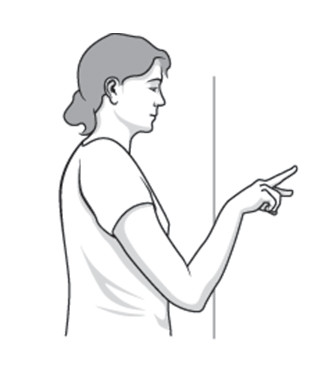
- sees the wall three-region of arm’s length.
- disclose and touch the wall at the side of the waist level with the fingertips of the affected arm.
- the elbow is slightly bent and slowly walk the fingers upward to the wall, such as a spider, until the raised arm is as far as comfortable. movement of the fingers, not the shoulder muscles.
- gently down the lower arm & repeat.
Perform the finger walk exercise 10 to 20 times per day.
Cross-body reach
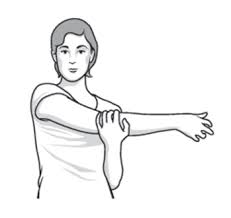
- Use the unaffected arm to lift the affected arm at the elbow & bring the arm up and across the body,
- exert gentle pressure to stretch the shoulder.
- The cross-body stretch is held for 15 to 20 seconds.
- repeat this exercise 10 to 20 times per day.
Armpit stretch

- Use the unaffected arm, and lift with the affected arm about breast-high.
- slightly bent the knees and open up the armpit.
- Depending on the knee bend slightly, and gently stretch the armpit.
- When each knee bend then stretches a little further, but not to force it.
- perform armpit stretches 10 to 20 times each day.
Pectoralis stretch

- Stand in a door frame with arms sideways. grasp onto the door frame and take a few steps forward until a stretch is felt in the bicep and shoulder region. Hold the stretch for 5-10 seconds in 1 minute then relax, 2 reps.
Internal Rotation Belt Stretch

- Grab an old belt or dog leash. Place the involved hand behind the back and start by pulling the belt across the buttocks. Hold for 5-10 seconds. Repeat for 1 minute 2 sets.
- Progression: Place the involved hand behind your back and pull the belt with the non-involved hand to progress the backhand upward along the spine. Repeat for 2 minutes.
Posterior capsule stretch
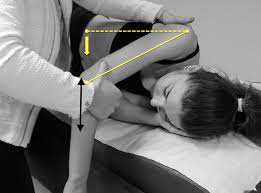
- Patient position: side lying
- position of therapist: stand beside the patient
- procedure: hang the affected arm at the edge of the table and the unaffected arm behind the ear with elbow flexion 90 degree
- the therapist’s left hand over the back side of the shoulder joint, right hand on the elbow joint
- gently apply stretch by therapist’s left hand
- hold for 2 seconds
- reps: 3 to 5 times
Sleeper stretch
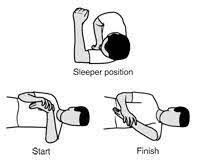
- Roll onto the involved shoulder. Place the elbow parallel with the shoulder. With the non-involved side, push the forearm down towards the floor. Hold for 30 seconds, 3 reps
Upper thoracic stretch
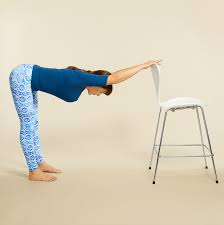
- Stand concerned the arm’s length far from a staircase banister or kitchen sink. Hold onto the banister and lean body forward until a stretch is felt in the upper shoulders and back. Hold for 1 minute, 2 reps
Yoga exercise of the frozen shoulder :
- Paschim Namaskarasana
- Ardha Matsyendrasana
- Bhujangasana
- Halasana
- Dhanurasana
- Garudasana
- Ustrasan
- Purvottanasana
Paschim Namaskarasana (Reverse Prayer Pose):

- Start with the Tadasana keep hands straight and hang on either side. Relax the shoulders and bent down the knees a little. stretch the arms backward and attach the palm together like in a prayer pose.
- When gradually inhaling press the palm of the inner surface towards the spine and hold this position for a few seconds.
- Now gradually exhale & move the palms downwards & come back to the starting pose.
- Repeat the yoga exercise 4-5 times for better results.
Ardha Matsyendrasana (Sitting Half Spinal Twist):
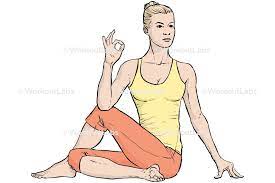
- Straight Sit with the legs stretch out and feet together.
- Bent the right leg and place to heel of the right foot beside the left hip.
- catch the left leg over the right knee.
- Put the right hand on the left foot & the left hand behind yourself.
- Twist to waist, shoulders, & neck to the left & look over to the left side shoulder.
- Hold this position & continue to breathe in and out slowly.
- Come back to the normal starting position Slowly
- perform this yoga in the same manner on the other side
Bhujangasana (Cobra Pose):–

- Lie down flat on the stomach and place the head on the ground.
- Keep both hands on each side of the shoulders.
- Slowly, put pressure on the palm & lift the body from the torso while stretching the back & belly muscles.
- Straight the arms and keep to shoulder blades pressed against the back.
- Fix the gaze at the point of the ceiling & hold the position for 15-30 seconds.
- Then exhale and come back to the normal position
Halasana (Plow Pose):-
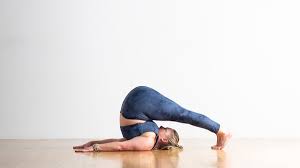
- Lies on the back, raise both legs above to stomach.
- Bend the body & try to extend the legs above to head and touch the ground with the toes.
- Hold the position for 10-15 seconds, relax for a minute, and repeat this exercise.
Dhanurasana (Bow Pose):-
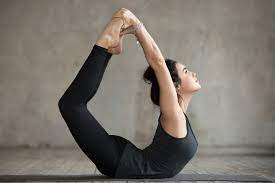
- Lie flat on your stomach and raise both legs and torso backward.
- Extend the arms backward and grasp both feet with the hands.
- Hold the posture for as long as possible & breathe in normally.
- Return to normal position & repeat this exercise 5-6 times
Garudasana:-
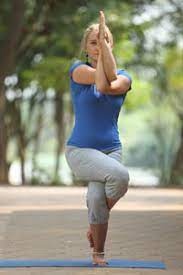
- Stretch to shoulders & upper back.
- Loosen the shoulder and release any tension in them.
Ustrasana:-
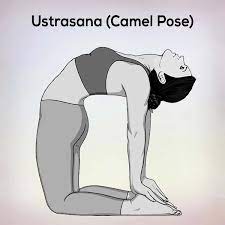
- Stretch & strengthening of the front the body.
- Relieve the body of lower backache
Purvottanasana:-
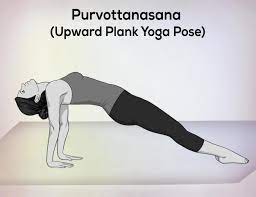
- give Stretch to the shoulder, chest, neck
- give Strength to the shoulder, back, ankle & wrist
Active assisted exercise for frozen shoulder
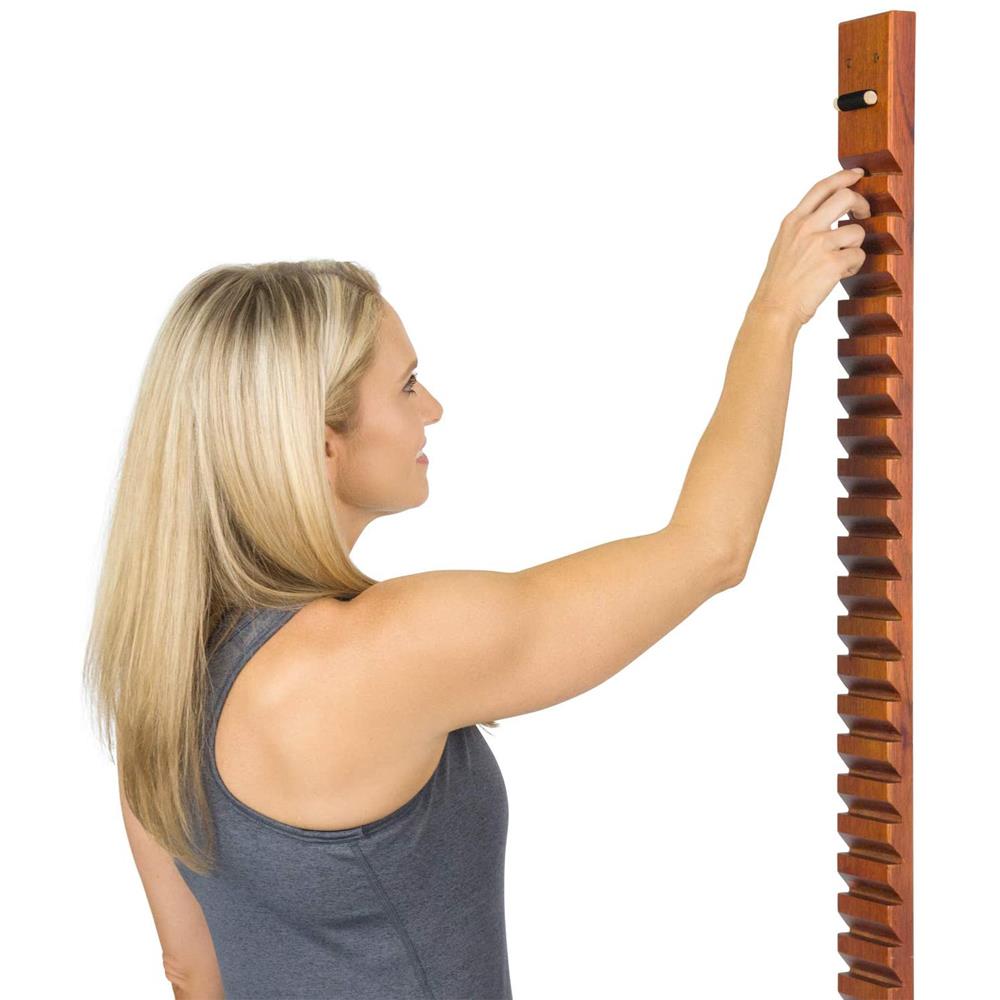
finger ladder
- ask the patient to stand(front and side) facing the ladder and moves the finger of the affected side shoulder upward along with the ladder to reach the maximum limit
- 10 repetitions 3 times a day
shoulder wheel:
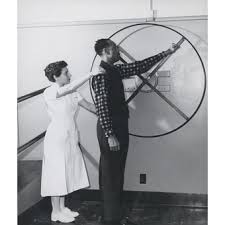
- ask the patient to stand sideways on the shoulder wheel and grasp the holder and moves the shoulder wheel clockwise and anticlockwise
- 10 repetitions 3 times a day
rope and pulley:
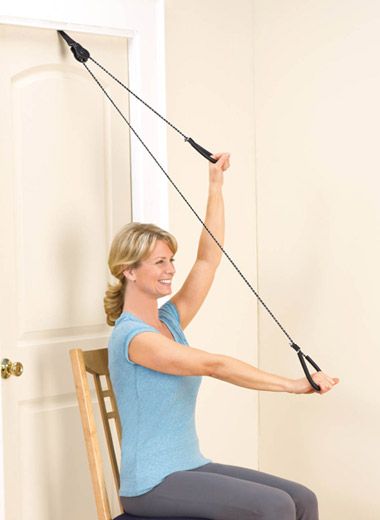
- ask the patient to stand or seat in the chair with back support then hold the handle of a pulley with both hands then move the painful hand upward side in form of shoulder flexion
- 10 repetitions 3 times a day
Strengthening exercise for frozen shoulder
- various exercises which strengthen the shoulder joint
- strengthening exercise perform in the progression stage of frozen shoulder
Equipment used to strengthen the shoulder joint
- dumbell
- theraband
- weight cuff
Dumbell shoulder press
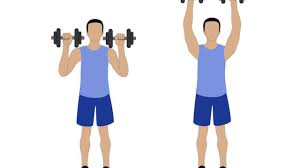
- steps: a seat on the chair
- start with lightweight( then progress to heavyweight )dumbells at sideways
- lift the dumbells upward to the start position
- move the dumbells upward in front of the shoulder(start position)
- lift the dumbells straight up in steady and control movement
- extend the arm (end position)
- return to start position
- hold the position for 2 second
Dumbell side raises
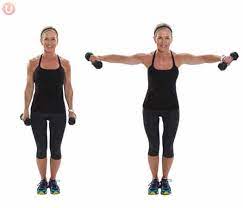
- start with a stand position with perfect posture
- hold the dumbells sideways palm face each other
- lift the dumbell straight out to sideways until arms are parallel to the ground
- hold the position for 2 second
- return to normal position
Dumbell front raise
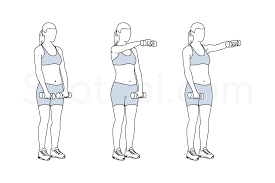
- start with a stand position
- hold the dumbells like palms and face the body
- lift the dumbells straight out to the front until arms are parallel to the floor
- hold the position for 2 second
- return to normal position
Bent over dumbell side raise
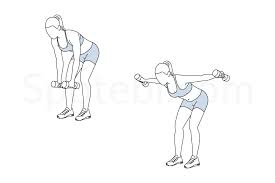
- start with standing after that bent the body to the waist so the upper body is parallel to the floor
- keep back straight
- hold the dumbell straight downward side
- lift the dumbell straight out to sideways in a reverse fly movement
- hold up the position for 2 second
- return to normal position
Dumbell upright row
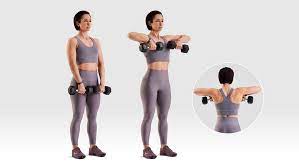
- grab the dumbells and stand up straight with the weight resting on the front of the thigh
- palm face downwards
- engage the shoulder and lift the hands and elbow upward
- keep palm face to the floor
- at the top of the movement when the shoulder muscle fully contracted
- weight on the hand should be in line with the shoulder and face forwards
- bent the elbow 90 degree
- hold the position for 2 second
- return to normal position
- 3 sets per set 8 to 12 reps
Dumbell shoulder shrug

- pick up dumbell in each hand and hold the weight outside the hips (sideways of thigh)
- arm fully extend with elbows relax
- lift the dumbell as high as possible
- shrug the shoulder upward towards the ear
- hold for 2 seconds before lower down shrugging shoulder
- 3 sets per set 8 to 12 reps
In the strengthening exercise with dumbells the anterior, middle, and posterior muscle (deltoid) used
This exercise improves the mobility of the shoulder joint
Theraband exercises for frozen shoulder
5 colors of theraband are used for exercise depending upon the tolerance of the patient with frozen shoulder
- start with yellow theraband low resistance and then progress to red, green, blue, black, silver, and golden theraband highest resistance
- yellow 3.0 lbs
- red 3.7 lbs
- green 4.6 lbs
- blue 5.8 lbs
- Black 7.3 lbs
- silver 10.2 lbs
- golden 14.2 lbs
- this number shows a different level of resistance
Outward rotation:–
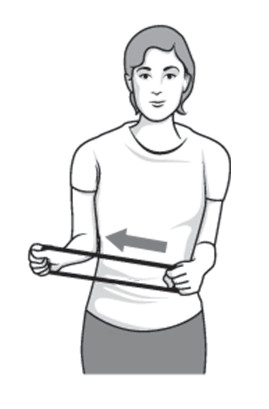
- Hold the theraband between the hands with the elbows at an angle of 90-degree close to the sides.
- moves clockwise the lower part of the affected arm outward to two or three inches, hold for five seconds.
- Repeat outward rotation 10 to 15 times, one time a day.
Inward rotation:-
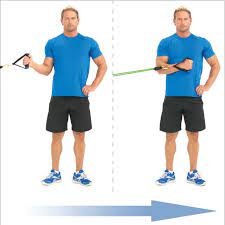
- Stand close to the door and hook one end of the rubber exercise band around the doorknob.
- Hold the other end in the hand of the affected arm, and hold the elbow at an angle of 90-degree.
- Pull the theraband toward the body 2 or 3 inches and hold for 5 seconds.
- Repeat this exercise 10 to 15 times, one time a day
Shoulder flexion with theraband
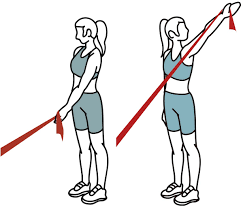
- grab the one end of theraband by the patient and another end of theraband built on the door knob
- ask the patient to snatch theraband upward towards the ceiling
- come back to downward
- demonstrate shoulder flexion with theraband 2 to 3 times daily
- 10 reps each time
Shoulder abduction with theraband
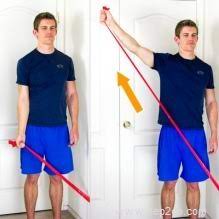
- grab the one end of theraband by the patient and another end of theraband placed below the sole of the foot
- ask the patient to snatch theraband away from the body
- come back to the neutral position
- demonstrate shoulder abduction with theraband 2 to 3 times daily
- 10 reps each time
Shoulder adduction with theraband
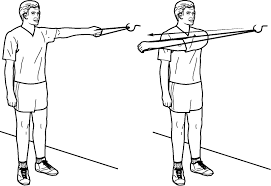
- grab the one end of the theraband by the therapist and another end of the theraband by the patient
- ask the patient to snatch theraband outside away from the body
- come back to the neutral position
- execute shoulder adduction with theraband 2 to 3 times daily
- 10 reps each time
- these exercises performed by the therapist
Weight cuff exercise for frozen shoulder
- various k.g weight cuff is used
- 0.5 kg ,1 kg,1.5 kg,2 kg
Shoulder flexion
- patient position: supine, sitting on a chair, standing
- built the weight cuff on the wrist joint
- start with a low kg weight
- gradually increase weight when the patient starts to achieve progress
- ask the patient to move the arm upward
- hold the position 2 second
- gradually moves the arm downward
- perform the exercise 2 to 3 times daily
- each time 10 reps
- another strengthening exercise with weight cuffs also do in the same manner by using different k.g weight cuff
Home exercise for frozen shoulder
foundational stage
Stick shoulder flexion
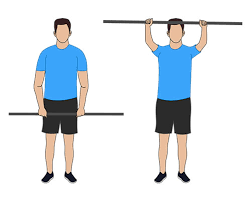
- position:seated,standing
- step 1:hold the stick upright in front of yourself
- step2:lean forward onto the stick
- step3:feel shoulder stretch in flexion
- reps: hold for 30 seconds
- sets:3 sets 30-second break between each set
- frequency:3 to 5 times per week
Stick shoulder abduction
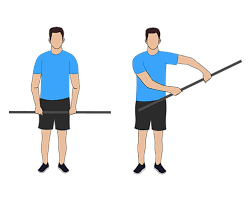
- position: stand straight or supine
- step 1:grab the stick with the palm on the right-hand point away from the body, left palm face the body
- step2:keep elbow straight and place it at your side
- step3:use the left arm to push the right arm as high as it will go to the right side
- step4:slowly lower the right and left arm, repeat for another side, switch the hand position such as left palm away from the body, right palm face the body
- reps:10 to 15 times each side
- set:3 sets
- frequency:3 to 5 times per week
Stick shoulder rotation
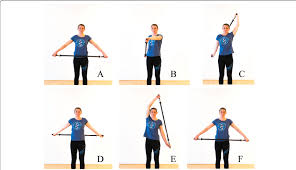
- position: stand or supine
- step1:grab the stick or towel with both hands, keep the elbow bent 90 degrees and place at the inward side
- step2:circumdactory movement of the hands all the ways to clockwise, repeat the movement of hands all the way to anti-clockwise (left side)
- reps:10 to 15 times each side
- set:3 sets
- frequency:3 to 5 times per week
Stick overhead shoulder stretch
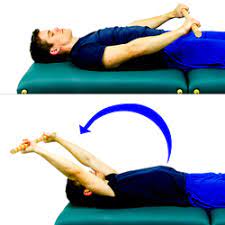
- position: supine
- step 1:lies on the back with stick hold overhead
- step2:lower the hands overhead and feel the stretch
- step3:try to keep the back of the shoulder against the floor and core muscles tighten throughout the movement
- step4:hold for 5 to 10 seconds
- step5:raise arm overhead and repeat
- reps:8 to 10 times
- set:3 sets
- frequency:3 to 5 times per week
Intermediate stage
Continue with the foundational stage
broom pull
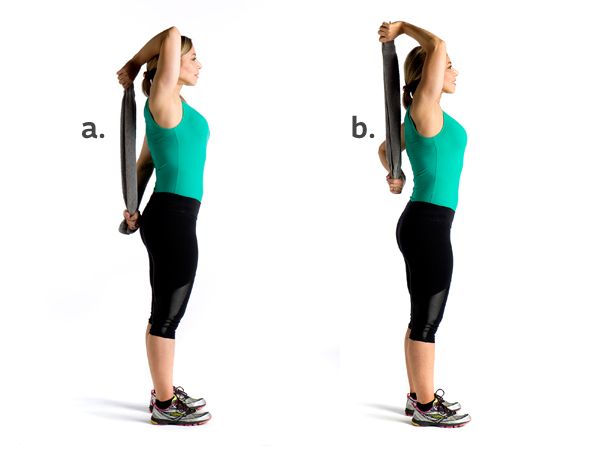
- position: stand
- step1:grab a broomstick or towel with both hands, one hand above the head and another hand behind back
- step2:pull with top of the hand, feel lower arm and shoulder stretch, repeat with another arm
- reps: hold for 10 to 15 second
- sets:3 sets with a 30-second break with each set
- frequency:3 to 5 times per week
stick shoulder extension
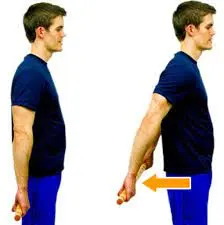
- position: standing
- step1:hold stick, broom, cane behind the back, extend arm behind the back
- step2:keep shoulder blade squeezed together, and feel the stretch in chest muscle while avoiding pain and tension in the shoulder
- reps: hold for 30 second
- sets:3 sets with a 30-second break with each set
- frequency:3 to 5 times per week
- All exercises in the intermediate stage improve range of motion, stretching, mobility
Home-based strengthening exercise for frozen shoulder
Low row
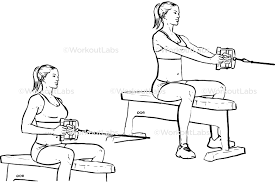
- position: standing or seated on a stability ball
- step1:attach a theraband to a solid object
- step2:squeeze shoulder blades together, reach backward with elbows, pull theraband towards you
- step3:allow the theraband to retract forward again, but keep engaged shoulder blades together
- reps:10 to 15 times
- sets:3 to 5
- frequency:3 to 5 times per week
- level2:put left arm and left knee on a bench with a weight in the right hand, a bring weight to the chest
- perform to the left side
Straight arm lateral pull down
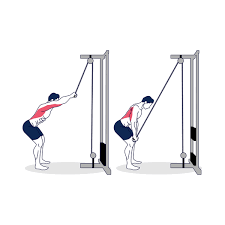
- position: standing or seated on the stability ball
- step1:attach a theraband to a solid object
- step2:squeeze shoulder blades together, reach backward with elbows, pull theraband towards you
- step3:allow the theraband to retract forward again, but keep engaged shoulder blades together
- reps:10 to 15 times
- sets:3 to 5
- frequency:3 to 5 times per week
Advance stage
continue with foundational and intermediate stages exercises
Scaption
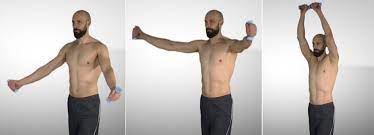
- position: stand
- step1:bring hands 20 degrees to 30 degrees in front of thumb pointed towards the ceiling
- step2:slowly raise hands overhead while trying to keep the shoulder down and shoulder blades, core muscles activated
- step3:slowly return to the start position
- reps:8 to 10 time
- set:3 sets
- frequency:3 to 5 times per week
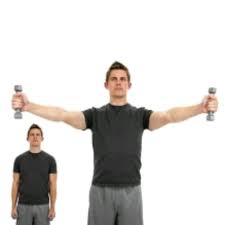
- level2:add 1 or 2 lb weight
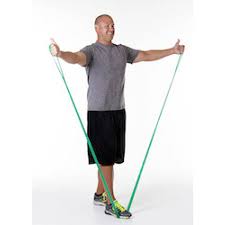
- level3:stand middle of theraband and grab its ends
Strengthening exercise for frozen shoulder in advanced stage
External rotation with theraband
- position: stand or seated on the exercise ball
- step1:use theraband
- step2:squeeze shoulder blades while activating core muscles
- step3:slowly rotate the arm outwards while keeping the elbow midline
- step4:slowly return to the start position and try to keep constant tension on the theraband
- reps:10 times
- sets:3 to 5 sets
- frequency:3 to 5 times per week
- perform this exercise actively(by the patient)
Proprioception/functional exercise
Prone “t”,”y”,”l”,”w”
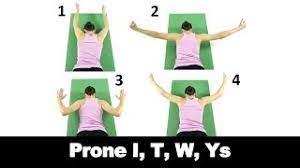
- position: face down on the floor with a towel under the forehead
- step1:engage the gluteal and abdominal muscle by drawing the belly button toward the spine
- step2:place the arm straight out to the side at a 90-degree angle with the body and thumb upward toward the ceiling
- step3:draw shoulder blade down and back, elevate arm off the floor, hold for 3 count
- step4:proceed to elevate the arm at progressive levels, resembling letters “y” and “l”, before bending the elbow, bring the arm sideways to make “w”
- step5:hold all four positions for 3 counts with the thumb pointed up toward the ceiling
- step6:reset the gluteal, abdominals, and shoulder blades muscles and repeat again
- reps:3 to 5 times
- sets:2 to 3
- frequency:3 to 5 times per week
T and Y are the most valuable exercises so concentrate on that exercise in the functional stage
When not to do exercise of frozen shoulder??
- stroke survivor
- adult aged 40 to 60 years
- people with hypothyroidism or hyperthyroidism
- people with a heart condition, Parkinson’s diseases
- women who have undergone mastectomy
- recent shoulder injury such as rotator cuff tear
- fracture of the upper arm, collar bone, shoulder blades
- a patient recovering from a medical procedure or condition that prevents her from move arm
- shoulder brace, shoulder splint
- pregnancy
- Recent fracture
- Recent pop
- Recent inflammation or injury
- Malignant tumor
Precaution for frozen shoulder
- do not stop move shoulder entirely because of pain
- do not do activities that involve sudden movement like heavy lifting to the affected side
- when recovery starts continue to make gentle movement
- avoid irritation
- doesn’t sleep on the affected side shoulder
- don’t miss a routine workout and physical therapy
- don’t neglect your diet
- stop smoke and drink
- consult shoulder specialist if frozen shoulder treatment fails
- do exercise after a doctor’s prescription
FAQs
Can exercise help a frozen shoulder?
Routine stretch, and exercise of the shoulder should help most people with frozen shoulders to relieve pain and improve their range of motion. Improvement usually takes time
Should you rest or exercise a frozen shoulder?
firstly best to do rest and gentle rhythmic shoulder mobility exercises. when the symptoms start to improve, people can do increasingly ambitious range-of-motion exercises for frozen shoulder
What exercises avoid if you have a frozen shoulder?
People with frozen shoulders should initially burden from exercises that inspire any movement like the movement overhead. activities like throwing a ball, and specific weight training at the gym like pull-ups avoid by patients who have a frozen shoulder
Which exercise is best for frozen shoulder?
stretching & strengthening exercises is best for a frozen shoulder
How do you treat frozen shoulders naturally?
Apply heat and ice to the affected area, which can help reduce the pain and swelling. Physical therapy includes gentle stretching and range-of-motion exercises


